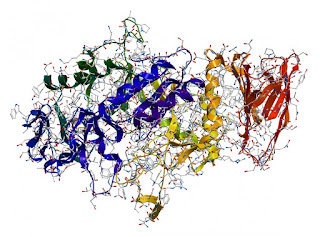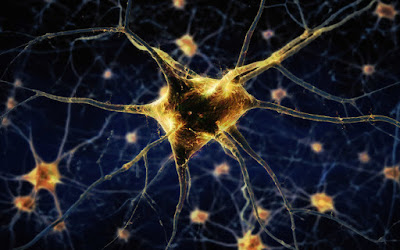 |
| https://en.wikipedia.org/wiki/Anselme_Payen |
 |
| https://www.medicalnewstoday.com/articles/319704.php |
To the left is an image of the enzyme diastase. As you can see, it is basically a glob of different string/ribbon-like objects, but this is only one way to view a protein. In this secondary structure, there are what is known as a beta sheet and alpha helix. A beta sheet, which appears to be the red ribbon on the image to the left is defined as being a wave-like structure. It is linked together by hydrogen bonding and it "allows for more hydrogen bonding by stretching the polypeptide chain" (8). The alpha helix is defined as being a spiral or coiled structure like the dark yellow ribbon right next to the red beta sheet. This structure is formed when the polypeptide chain twists, allowing the amino acids in the center to form hydrogen bonds with one another, ultimately creating a very strong helical structure (8). Overall, this image accentuates the secondary structure while a protein can be in a variety of different structures, such as in primary, secondary, tertiary, or a quaternary form that vary in appearance to the one I have provided. The image below shows a more accurate representation of all the different forms of proteins that can be found and also includes a close up on the alpha helix and beta sheet I described earlier.
An enzyme also contains what is known as an active site, which is a region on the enzyme that binds to a substrate, which is a reactant molecule. When the substrate binds to the enzyme, specifically onto the active site, an enzyme/ substrate complex is formed. Once the complex has formed, the enzyme will slightly change its shape to create an enzyme/ product complex in which the new product will form (4). As you can see in this gif below, the enzyme's active site is designed to connect to only specifically shaped substrates.
 |
| https://en.wikipedia.org/wiki/Protein_folding |
 |
 |
| https://gfycat.com/gifs/search/telomeres |
The green structure that is moving above is the telomerase at work. As you can see, the telomerase adds a complementary strand (the letters/bases in red) from the RNA strand, making the telomere longer. The length of the telomere is important because as the chromosome replicates, the end bases (at this point it is the telomere) fall off, and if all the telomeres are gone then the important parts of the DNA sequence will start to fall off (7). If DNA is lost, that can either mean one of two things: no effect or something really bad. Sometimes if a DNA sequence is missing there can be no effect on the end goal, but other times it can be the reason why we have certain diseases, like cancer. Overall, enzymes are very important for the essential processes in our bodies to run at the rate necessary for our survival.
Just remember...
 |
| https://gfycat.com/evilmealybirdofparadise |
References:
1) This website gives a brief description of the life of the French chemist Anselme Payan. The editors of Encyclopedia Britannica. Anselme Payen. Encyclopedia Britannica. https://www.britannica.com/biography/Anselme-Payen. Updated January 2, 2019. Accessed February 23, 2019.
2) This website gives a brief description of the enzyme Diastase, and I also used the dictionary definition of amylase. Diastase. Enzyme Education Institute. https://enzymeeducationinstitute.com/enzymes/diastase/. Accessed February 23, 2019.
3) This website gives a thorough description of what enzymes are and what specific functions. Newman, T. Enzymes: How they work and what they do. Medical News Today. https://www.medicalnewstoday.com/articles/319704.php. Updated January 11, 2018.
4) This website also talks about what enzymes are and their function, but also touch on the specifics, such as what an active site, substrate, cofactors, and environmental factors are. Enzymes and the active site. Khan Academy. https://www.khanacademy.org/science/biology/energy-and-enzymes/introduction-to-enzymes/a/enzymes-and-the-active-site. Accessed February 24, 2019.
5) This site briefly describes why are enzymes are essential for survival. Who am I?. Science museum. http://whoami.sciencemuseum.org.uk/whoami/findoutmore/yourbody/whatdoyourcellsdo/whatisacellmadeof/whyareenzymesimportant. Accessed February 24, 2019.
6) This website gives information about the function and relationship between telomeres and telomerase. Telomeres and telomerase. Khan Academy. https://www.khanacademy.org/science/biology/dna-as-the-genetic-material/dna-replication/a/telomeres-telomerase. Accessed February 24, 2019.
7) This website gives information about telomerase and its function. Telomerase. Biology Dictionary. https://biologydictionary.net/telomerase/. Published in 2018. Accessed February 24, 2019.
8) This website gives a brief description of the alpha helix and beta sheet in the secondary structure of a protein. Chapter Two: Organic Chemistry. The Virtual Cell Webpage. https://www.ibiblio.org/virtualcell/textbook/chapter2/ps1.htm. Accessed March 3.
8) This website gives a brief description of the alpha helix and beta sheet in the secondary structure of a protein. Chapter Two: Organic Chemistry. The Virtual Cell Webpage. https://www.ibiblio.org/virtualcell/textbook/chapter2/ps1.htm. Accessed March 3.













